Have you always wanted to know more about Workflow, but found yourself overwhelmed and mystified? Do you think your E-Business Suite Workflow environment needs to be tuned, but aren’t sure where to start? Are you curious to know the future of Workflow and BPEL? Would you like to see an example of how to convert a Workflow into a BPEL?
We have your solution! Solution Beacon and OAUG have joined forces once again to bring you a comphrensive book surrounding Workflow. The ABCs of Workflow for Oracle E-Business Suite Release 11i and Release 12 is now available for sale online.
Workflow is Oracle’s E–Business Suite tool for modeling business processes. Workflow combines procedures performed by the computer with a system of notifications that allow humans to better direct the computer how to proceed. This book provides a very thorough explanation of the various components of Workflow. You’ll learn step by step how to develop and test custom workflows, and how to administer Workflow using OAM, the Workflow Management screens, and Oracle Diagnostics.
This book also explains how the underlying tables store the data generated by Workflow, and how to perform the setups required for a few of the most commonly used Oracle workflows. The book also includes SQL scripts amd sample procedures that we use at Solution Beacon to assess and solve Workflow problems, as well as DBA topics like cloning considerations and partitioning Workflow objects.
We have also provided two special sections. The first section explains the use of Approvals Management Engine (AME) in Workflow and includes several case studies for developing approval rules. The second section gives an overview of BPEL and explains how to transform the workflow used in this book into a BPEL process.
Workflow is used pervasively throughout the E-Business Suite. If you’re running E-Business Suite Release 11i or Release 12, you’re using Workflow! The ABCs of Workflow should be on the desk of every Workflow Developer, Workflow Administrator, Workflow Junior Administrator, Applications System Administrator, Applications Database Administrator and Functional SuperUser.
Visit our online bookstore to purchase your copy today! http://stores.lulu.com/store.php?fAcctID=83172
Tuesday, June 24, 2008
Thursday, June 19, 2008
Want to Add a Responsibility? How about Oracle User Management?
When you think of adding a new responsibility to an existing E-Business Suite user, does System Administrator come to mind? Visions of going to the Define User form, tabbing down and finding the new responsibility to add? Did you know that you can add responsibilities to a user through Oracle User Management? Let’s step through how this can happen together. Below I have setup a brand new user without any responsibilities.

Further evidence that there are no responsibilities tied to this user is in the screenshot below where I have logged into this new userid – notice there are no responsibilities listed.

Next, let’s login into the Oracle User Management responsibility and query up the new user “BOYWONDER” where we see again that there are no roles nor responsibilities assigned to this user:
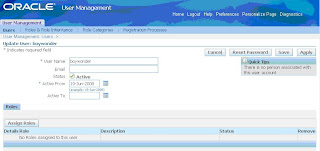
Now let’s go find the US Super HRMS Manager responsibility and assign that responsibility to BOYWONDER as follows:
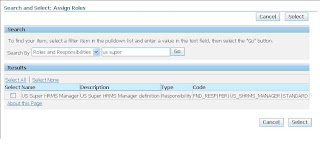
Now let’s re-query up BOYWONDER to see that the US Super HRMS Manager responsibility has been added in Oracle User Management as follows:
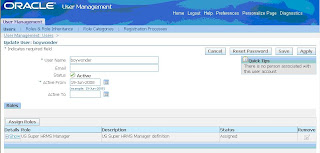
Now, let’s switch over to System Administrator and requery up BOYWONDER to see if the responsibility shows there:
As you can see, the responsibility has been added through Oracle User Management just as if it had been added through the System Administrator responsibility. Lastly, let’s log back into BOYWONDER and see if he is now a Super HRMS Manager for the US:

And there you have it – BOYWONDER is now an HRMS super hero in good standing. System Administrator? Who needs it – there’s a new super hero in town!

Further evidence that there are no responsibilities tied to this user is in the screenshot below where I have logged into this new userid – notice there are no responsibilities listed.

Next, let’s login into the Oracle User Management responsibility and query up the new user “BOYWONDER” where we see again that there are no roles nor responsibilities assigned to this user:

Now let’s go find the US Super HRMS Manager responsibility and assign that responsibility to BOYWONDER as follows:

Now let’s re-query up BOYWONDER to see that the US Super HRMS Manager responsibility has been added in Oracle User Management as follows:

Now, let’s switch over to System Administrator and requery up BOYWONDER to see if the responsibility shows there:
As you can see, the responsibility has been added through Oracle User Management just as if it had been added through the System Administrator responsibility. Lastly, let’s log back into BOYWONDER and see if he is now a Super HRMS Manager for the US:

And there you have it – BOYWONDER is now an HRMS super hero in good standing. System Administrator? Who needs it – there’s a new super hero in town!
Tuesday, April 29, 2008
New Feature for Release 12 – “Manage Proxies”
Ever wanted to get even with those pesky auditors that are always making life more difficult than it has to be just to achieve some level of controlled nirvana? Well, I have just the prescription in the form of a new feature in Release 12 called “Manage Proxies” – this new feature is guaranteed to send the auditors into counseling! This new powerful feature allows Release 12 users to designate a proxy user which can then assume, takeover, inherit, (insert your favorite verb here ______) all, yes ALL, the accesses possessed by the granting user. According to the Release Control Document for Release 12, the rationale behind adding this feature is to allow administrative assistants the ability to manage approvals for their too busy executives; however, there are other ways to accomplish this within the Approvals Management Engine (AME) that doesn’t bring all the controls baggage with it like the “Manage Proxies” function does. To setup a proxy user, all it takes is the assignment of the “Manage Proxies” role which then causes the “Manage Proxies” selection to appear when Preferences are selected from the granting user’s home page (see below). Clicking on the “Manage Proxies” link takes the granting user to a page where one or more proxy users can be added.

Once the “apply” button is hit, then auditor heartburn occurs! The next time the proxy user(s) logs in he/she has “Switch User” displayed in the upper right hand corner of their home page as shown below.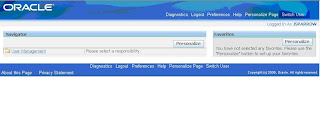

All the proxy user has to do is “Switch User” and bingo, the proxy user now has all the responsibilities from the granting user and can masquerade as that user until the proxy is revoked by the granting user which is shown below.
Of course the proxy user can exercise a very deep philosophical action called “Return to Self” which reverts the proxy user to their original list of responsibilities, but until self actualization occurs, Release 12 schizophrenia exists in all its glory! The only problem is that the mental health hit is not realized by the proxy user nor the granting user – but the poor auditor which discovers this new feature in Release 12 called “Manage Proxies” – enjoy and don’t say you weren’t warned!!!!
Labels:
Audit,
Oracle E-Business Suite EBS,
release 12,
UMX,
User Management
Wednesday, April 9, 2008
Some New Thoughts for an Old Friend (iSetup)
Oracle has given an old friend a facelift in Release 12. Among some of the nips and tucks you will find the ability to create custom selection sets, comparison reports between multiple environments and a new process flow that promotes “Transformation” to a process all by itself. In addition to congratulating “Transformation” on it’s new found level of achievement, let’s dive in and discover what the new and improved Release 12 version of iSetup has in store for us, ok?
The integration between iRepository and iSetup has been strengthened in that any interface and/or API that is defined to iRepository can be defined to iSetup which is the underpinning for creating custom selection sets within iSetup. This opens up the playbook for iSetup by providing access to data objects never before experienced and if iSetup can get to those data objects, that means migration nirvana can be achieved between environments for those objects. What is even more impressive is how Oracle has reinforced iRepository with all the open API’s and interfaces in and out of the E-Business Suite footprint. This allows for a higher degree of reach for iSetup into data objects heretofore unreachable.
Next consider running a comparison report, but only being able to run the comparison against one environment? How counter-intuitive is that? Doesn’t comparison infer checking one environment against another? Well, now the comparison reporting function does just that, it can be pointed to multiple environments and behold, comparison deltas are reported – how cool is that?
Lastly, let’s turn our attention back to our friend “Transformation” which just got promoted. The process flow for 11i iSetup is below:
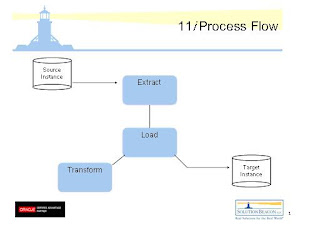
Would enjoy hearing about your experiences with iSetup and get your reactions to the Release 12 improvements.
The integration between iRepository and iSetup has been strengthened in that any interface and/or API that is defined to iRepository can be defined to iSetup which is the underpinning for creating custom selection sets within iSetup. This opens up the playbook for iSetup by providing access to data objects never before experienced and if iSetup can get to those data objects, that means migration nirvana can be achieved between environments for those objects. What is even more impressive is how Oracle has reinforced iRepository with all the open API’s and interfaces in and out of the E-Business Suite footprint. This allows for a higher degree of reach for iSetup into data objects heretofore unreachable.
Next consider running a comparison report, but only being able to run the comparison against one environment? How counter-intuitive is that? Doesn’t comparison infer checking one environment against another? Well, now the comparison reporting function does just that, it can be pointed to multiple environments and behold, comparison deltas are reported – how cool is that?
Lastly, let’s turn our attention back to our friend “Transformation” which just got promoted. The process flow for 11i iSetup is below:

You will notice that you don’t have to run a load process any longer in order to perform a transformation of your data objects.
One important note on iSetup that hasn’t changed is that the source and target environments must be at the same version of E-Business Suite, keeping iSetup geared for implementations and migration of configuration changes between environments.
One important note on iSetup that hasn’t changed is that the source and target environments must be at the same version of E-Business Suite, keeping iSetup geared for implementations and migration of configuration changes between environments.
Would enjoy hearing about your experiences with iSetup and get your reactions to the Release 12 improvements.
Labels:
11i,
12,
iSetup,
iSetup Configurator,
iSetup Migrator,
Oracle,
Oracle E-Business Suite EBS
Wednesday, February 20, 2008
Role Based Access Control (RBAC), Oracle User Management (UMX) and Release 12
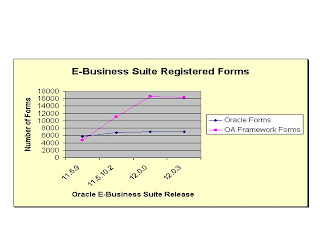
There are three dynamics that come together in Release 12 to produce inflection points where increased levels of access may not have adequate enough controls surrounding them. First and foremost is the emergence of OAFramework applications within the Release 12 footprint which is depicted in the chart to the left.
One of the reasons this is so important is that OAFramework applications look to Oracle User Management (UMX) roles for their security framework which means ever increasing levels of access are being granted through UMX roles rather than through traditional system administration responsibilities and menus. An example of one of these inflection points is in Oracle Cash Management where bank accounts are assigned to Legal Entities through the granting of a specific UMX role. In fact, Oracle Cash Management was redeveloped in OAFramework in Release 12 which is probably a template that Oracle will follow for other applications in future releases.
This emergence of OAFramework challenges our traditional ways to audit the various access levels across the Release 12 footprint. As we all know, Oracle designs “great privilege” into their base deliverables as evidenced by the Payables Manager responsibility and the General Ledger Super User responsibility. “Great privilege” is the second dynamic that is submitted for your consideration. I trust nobody is using the out-of-the-box responsibilities in their production environments, but if “great privilege” is designed into traditional system administration access levels, what about the OAFramework/UMX roles?
Couple “great privilege” with our third dynamic, “inheritance” and you have just poured fuel on the roaring controls fire we’ve been building. “Inheritance” is where a new person inherits all application accesses from another person who has been performing the same role for some period of time. Usually inheritance is a good thing, but in this case, the new AP clerk just inherited all accesses from the other AP clerk who may have been working at that company for 20 years. So, in one simple authorization, the new AP clerk now has 20 years worth of accesses which may or may not be understood, intended nor authorized.
So, let’s recap, there are three dynamics at play here (1) emergence of OAFramework and UMX roles, (2) “great privilege” being designed by Oracle and (3) the ease of “inheritance” which erodes individual authorizations across the Release 12 footprint. Role Based Access Control (RBAC) can mitigate these three dynamics if adopted and designed appropriately. In our next post, we will take a deeper look at RBAC to understand what it is and how it can be designed and deployed at your company to effectively mitigate the new controls inflection points created in Release 12 where traditional system administration meets the emergence of OAFramework and UMX.
Labels:
OAFramework,
RBAC,
release 12,
UMX
Monday, September 17, 2007
Making Sense of Fusion Middleware
The Fusion Middleware area has become more and more crowded with all of the products that are now included.
I speak from personal experience on this topic since I'm often stumbling through the various acronyms used for these products.
Most of us think that Fusion Middleware refers to Service-Oriented Architecture, Identity Management and Business Process Management since these are usually the emphasis of Oracle's presentations. In actuality there's an amazing breadth of other solutions when you dig into Oracle's offering.
To add to the complexity, some of Fusion Middleware products are further grouped into Suites for marketing purposes. That's good because the Suites are targeted to specific business needs. If you are looking for Business Process Management it's nice to find that term. The downside is that it can be confusing when the same product can be found in multiple Suites.
For example, compare the Event Driven Architecture Suite and the Service-Oriented Architecture Suite components. You will find that they both include Business Activity Monitoring, the Enterprise Service Bus, Enterprise Messaging (Java Messaging), and Business Rules. Then they add one or more other different Fusion Middleware products.
So, if we really want to understand the Fusion Middleware products it's best to break them down individually and understand their general capabilities. I've done that in a PDF file available here. Once you see it, you'll understand why I didn't just publish it here.
For those who are too busy/lazy to peruse the PDF file, here's a brief overview of the various components of the larger product groups/suites in the Fusion Middleware and what they currently include.
I speak from personal experience on this topic since I'm often stumbling through the various acronyms used for these products.
Most of us think that Fusion Middleware refers to Service-Oriented Architecture, Identity Management and Business Process Management since these are usually the emphasis of Oracle's presentations. In actuality there's an amazing breadth of other solutions when you dig into Oracle's offering.
To add to the complexity, some of Fusion Middleware products are further grouped into Suites for marketing purposes. That's good because the Suites are targeted to specific business needs. If you are looking for Business Process Management it's nice to find that term. The downside is that it can be confusing when the same product can be found in multiple Suites.
For example, compare the Event Driven Architecture Suite and the Service-Oriented Architecture Suite components. You will find that they both include Business Activity Monitoring, the Enterprise Service Bus, Enterprise Messaging (Java Messaging), and Business Rules. Then they add one or more other different Fusion Middleware products.
So, if we really want to understand the Fusion Middleware products it's best to break them down individually and understand their general capabilities. I've done that in a PDF file available here. Once you see it, you'll understand why I didn't just publish it here.
For those who are too busy/lazy to peruse the PDF file, here's a brief overview of the various components of the larger product groups/suites in the Fusion Middleware and what they currently include.
- The Application Server is the core component of Fusion Middleware. It provides J2EE 1.4 support, Web Services Support, Enhanced Messaging, Transaction Management, Security Features, Clustering, Grid Computing, and Monitoring & Management.
- The Business Integration Suite includes products like Master Data Management, XML Gateway, B2B Integration and the BPEL Server.
- The Business Intelligence Suite includes Warehouse Builder, OBIEE, BI Publisher, BI Answers, BI Discoverer and the Hyperion products.
- The Business Process Architecture Suite provides the ability to model, simulate and publish business process models.
- The Business Process Management Suite is a superset of the Business Process Analysis Suite and the Service-Oriented Architecture Suite.
- The Collaboration Suite includes groupware, unified messageing and real-time collaboration products.
- The Content Management Suite supports content management, publishing, tracking and distribution with retention policy capability.
- The Event Driven Architecture Suite is a marketing package that includes products that generate and report on events.
- The Identity and Access Management Suite provides LDAP, Single-Sign On, Federation, and Virtual Directories.
- The Middleware for SMB provides a lower-end solution that meets the needs of Small and Medium-sized busineses using the Standard Edition One of the application server.
- The Middleware for Applications is a marketing package that includes middleware products for each of the application suites.
- The Service Delivery Platform offers new communication options including Residential VoIP, virtual PBX and the Communication and Mobility Server.
- The Service Oriented Architecture Suite includes those products used to define, orchestrate, monitor, secure and tune the execution of Web Services.
Labels:
10g application server,
EDA,
Fusion Middleware,
Oracle,
SOA
Friday, September 7, 2007
Options for Generating XML for BI Publisher
Oracle's BI Publisher is a powerful tool for producing richly formatted documents. It takes any well-formed XML data and refines it into custom invoices, checks, bar coded labels, web pages – the possibilities are limitless. The source for the XML data can be any process that can generate well-formed XML data ("well-formed" simply means that it complies with XML standards). In the Oracle Applications world, this typically means creating a duplicate of an existing report and then modifying its output to generate XML rather than text. However, there are many occasions where the report requirements don't correspond with an existing report and you'll have to look at other options to generate XML data.
BI Publisher Data Templates provide the overall best method for producing XML output that is to be used in conjunction with BI Publisher. Data Templates are themselves specially formatted XML documents that contain SQL code along with other processing instructions. They are relatively simple to construct requiring only a text editor and a working knowledge of the template elements and layout. Once complete, the Data Template is loaded into the Template Manager as part of the data definition. Everything is managed through BI Publisher thus eliminating the need to create a separate concurrent process. At runtime, execution is handled via the BI Publisher Java APIs and the entire process has been tuned to out-perform any other method for producing XML output. Keep in mind, however, that all the appropriate BI Publisher patches must be in place for Data Templates to be used and this is usually not the case.
The PL/SQL XDK (XML Developer's Kit) packages offer a powerful option for generating XML data. The XDK provides methods for creating and manipulating XML documents through the DOM or Document Object Model. The DOM methods provide a maximum amount of control when generating new documents or modifying existing ones. Unfortunately, the learning curve is somewhat intense and it takes a substantial amount of coding to perform even the simplest of tasks. The XDK probably is best suited for hardcore developers who need an advanced level of control over XML generation.
You may also choose to generate your XML data using your favorite scripting language. Since XML data is really just specially formatted text, any process that can write text output can produce XML documents for use with BI Publisher. Perl, PHP and even shell scripting can be designed to generate XML as long as you follow the guidelines set forth by the XML standards. Many of these common scripting languages also offer add-on libraries specifically designed to simplify the process of generating well-formed XML documents. Plus, if you're already familiar with any of these languages then the implementation should be reasonably straightforward. There is a downside to this method. Most likely, you'll need to access data stored in the Apps database and this can get a little tricky when the script is called from a concurrent process. You'll need to install the appropriate libraries to access the Oracle database or make system calls to SQL*Plus.
Another little known method that can be used to produce XML data in many situations is SQLX or SQL/XML. SQLX has different meanings depending on the context. Typically, SQLX refers to a set of technologies used to query information from an XML database or document. SQLX also refers a set of functions used to within a SQL query to produce XML output. SQLX functionality is available in Oracle 9i or 10g databases but the latter versions provide much more usability. SQLX scripts can be setup as SQL concurrent requests and immediately processed with BI Publisher. They can also be embedded into PL/SQL procedures so that the output is written to a file and then processed with BI Publisher or further manipulated. The SQLX functions are intuitive and with a little ingenuity and experimentation, you should be able to quickly produce XML documents to meet most BI Publisher requirements.
Posted on behalf of:
Tim Sharpe | Solution Architect
BI Publisher Data Templates provide the overall best method for producing XML output that is to be used in conjunction with BI Publisher. Data Templates are themselves specially formatted XML documents that contain SQL code along with other processing instructions. They are relatively simple to construct requiring only a text editor and a working knowledge of the template elements and layout. Once complete, the Data Template is loaded into the Template Manager as part of the data definition. Everything is managed through BI Publisher thus eliminating the need to create a separate concurrent process. At runtime, execution is handled via the BI Publisher Java APIs and the entire process has been tuned to out-perform any other method for producing XML output. Keep in mind, however, that all the appropriate BI Publisher patches must be in place for Data Templates to be used and this is usually not the case.
The PL/SQL XDK (XML Developer's Kit) packages offer a powerful option for generating XML data. The XDK provides methods for creating and manipulating XML documents through the DOM or Document Object Model. The DOM methods provide a maximum amount of control when generating new documents or modifying existing ones. Unfortunately, the learning curve is somewhat intense and it takes a substantial amount of coding to perform even the simplest of tasks. The XDK probably is best suited for hardcore developers who need an advanced level of control over XML generation.
You may also choose to generate your XML data using your favorite scripting language. Since XML data is really just specially formatted text, any process that can write text output can produce XML documents for use with BI Publisher. Perl, PHP and even shell scripting can be designed to generate XML as long as you follow the guidelines set forth by the XML standards. Many of these common scripting languages also offer add-on libraries specifically designed to simplify the process of generating well-formed XML documents. Plus, if you're already familiar with any of these languages then the implementation should be reasonably straightforward. There is a downside to this method. Most likely, you'll need to access data stored in the Apps database and this can get a little tricky when the script is called from a concurrent process. You'll need to install the appropriate libraries to access the Oracle database or make system calls to SQL*Plus.
Another little known method that can be used to produce XML data in many situations is SQLX or SQL/XML. SQLX has different meanings depending on the context. Typically, SQLX refers to a set of technologies used to query information from an XML database or document. SQLX also refers a set of functions used to within a SQL query to produce XML output. SQLX functionality is available in Oracle 9i or 10g databases but the latter versions provide much more usability. SQLX scripts can be setup as SQL concurrent requests and immediately processed with BI Publisher. They can also be embedded into PL/SQL procedures so that the output is written to a file and then processed with BI Publisher or further manipulated. The SQLX functions are intuitive and with a little ingenuity and experimentation, you should be able to quickly produce XML documents to meet most BI Publisher requirements.
Posted on behalf of:
Tim Sharpe | Solution Architect
Subscribe to:
Comments (Atom)


